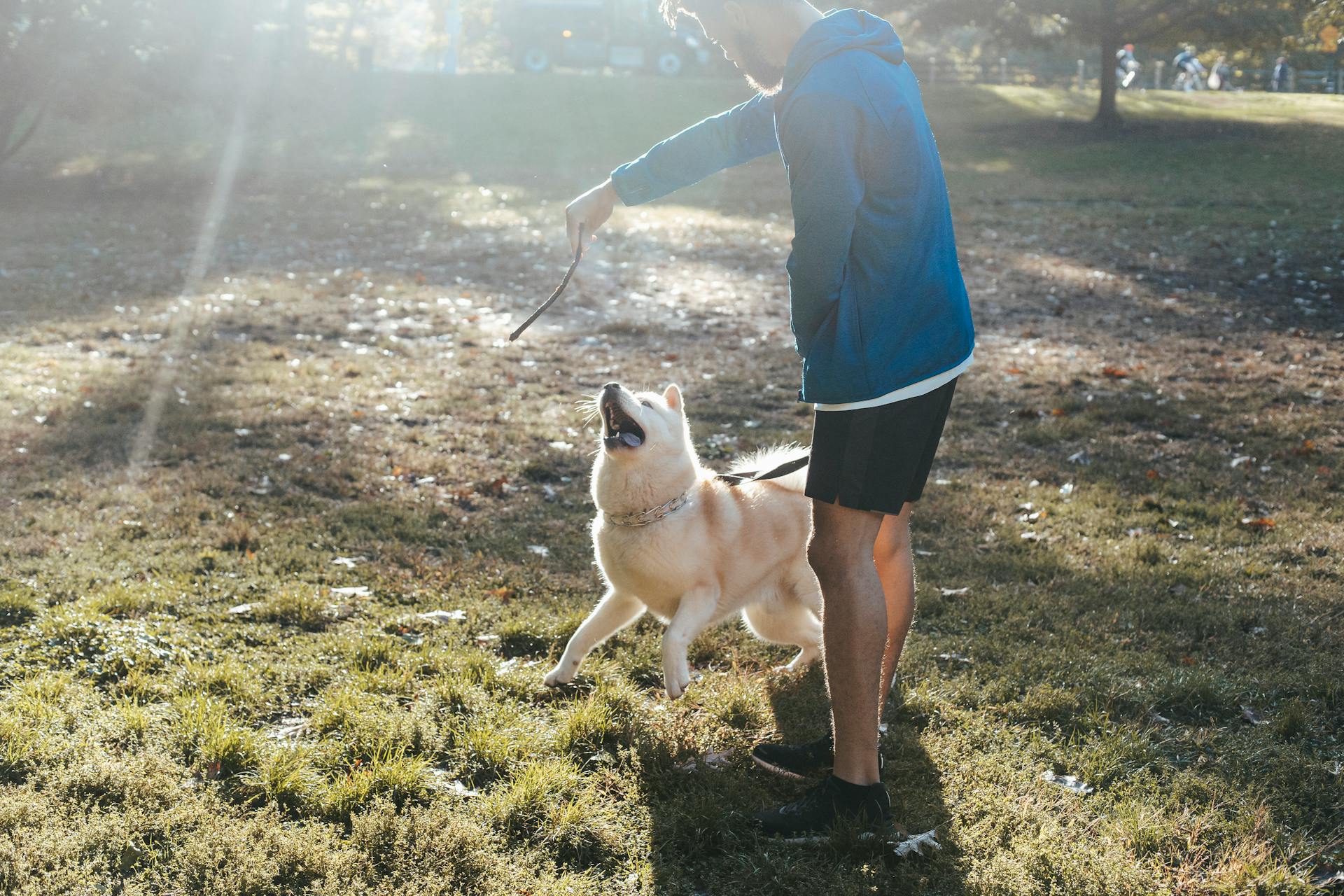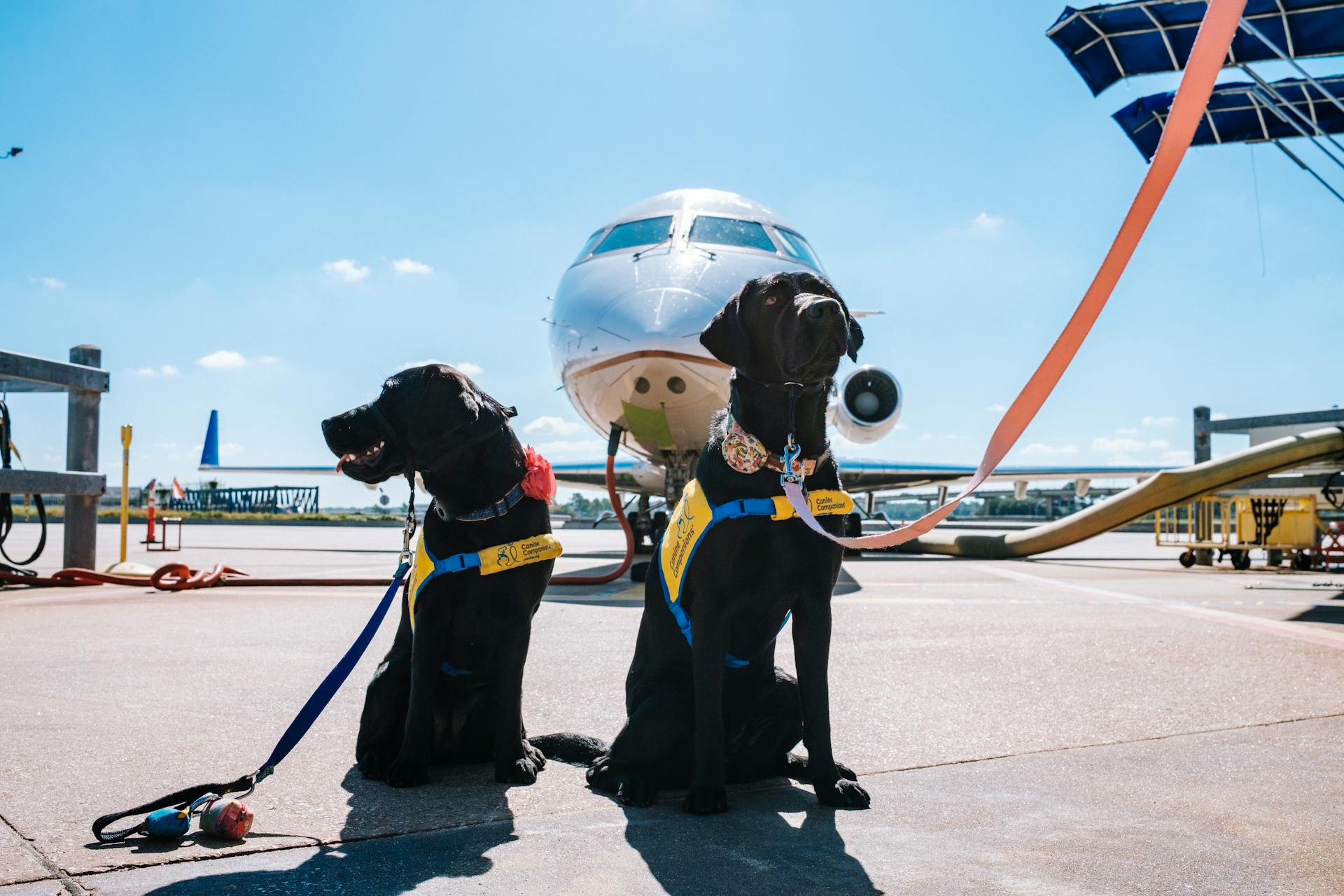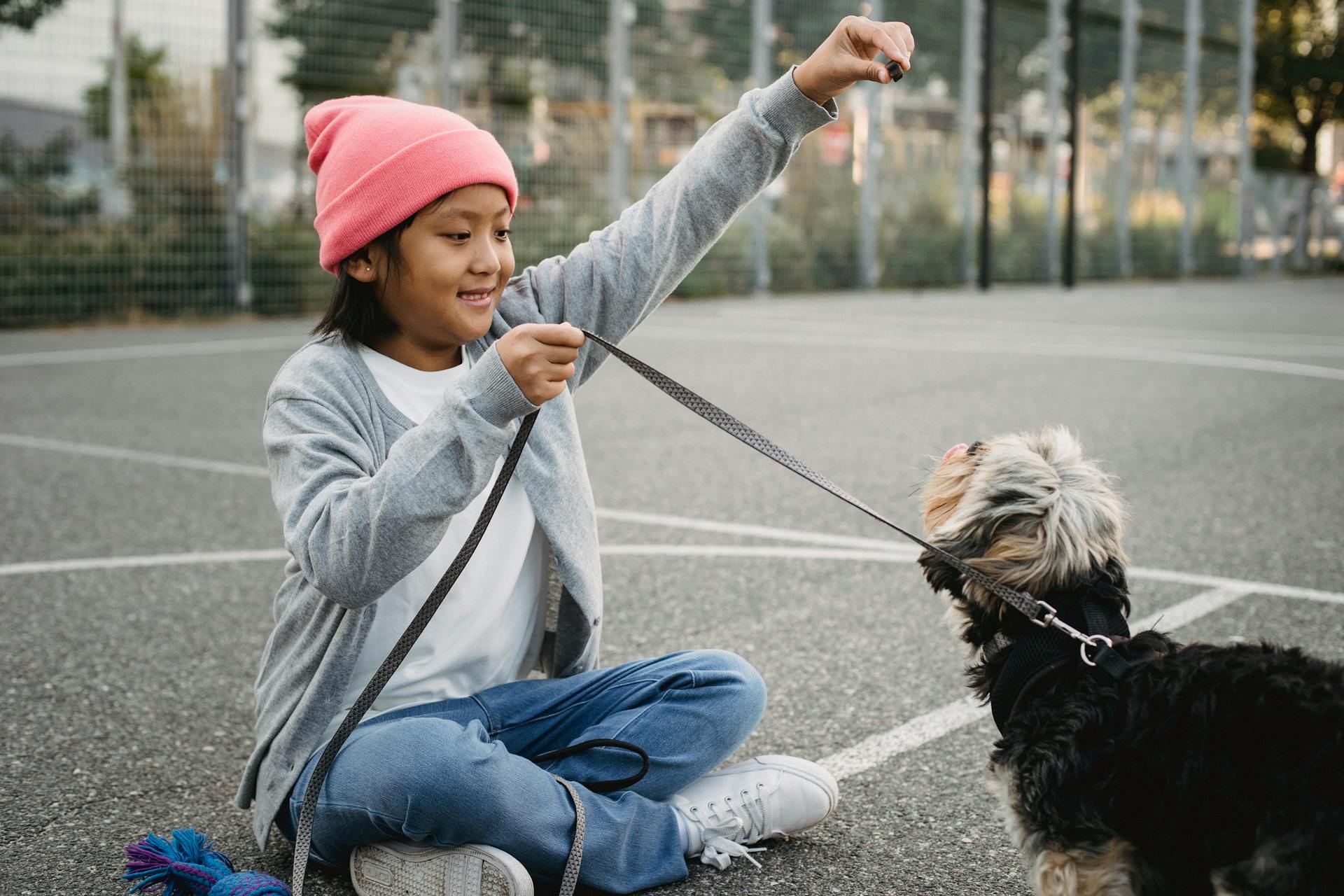
Service dogs play a vital role in assisting individuals with disabilities, and training them can be a significant investment. Fortunately, there are free training programs available for service dogs from start to finish.
The training process typically begins with socialization, which is a critical phase that lasts until the puppy is about 16 weeks old. This is where the puppy learns to interact with various environments, people, and other animals.
Free training programs often cover basic obedience commands, such as sit, stay, and walking on a leash, which are essential for a service dog's daily tasks. These commands are usually taught using positive reinforcement techniques, such as clicker training.
Service dogs also require advanced training in specific tasks, such as opening doors, picking up items, and providing physical support. This training is usually tailored to the individual's specific needs and can take several months to complete.
Related reading: Puppy Raiser for Service Dogs
What is a Service Dog?
A service dog is a highly trained animal that performs tasks to benefit a person with a disability. The Americans with Disabilities Act defines a service dog as one that has been trained to assist people with conditions like PTSD, autism, seizures, blindness, and more.
For another approach, see: Trained Companion Dogs
These dogs are often highly specialized and valuable, which makes them expensive to obtain. Some dogs are sponsored by charities and corporations, making them available for free or at a low cost.
The need for service dogs often outweighs the supply, leading to long waiting lists and high expenses. This can make it difficult for people who need a service dog to get one.
Worth a look: Do Service Dogs Need to Be Registered
Eligibility and Adoption
To be eligible for a service dog, you'll need to find a dog with the right temperament and health.
A suitable candidate should be of the right age, which is essential for a service dog.
You can find dogs with potential to be trained as service dogs at shelters and rescues, and adopting is often less expensive than purchasing from a breeder.
However, it's crucial to ensure the dog has the right temperament and capabilities for the job.
If you already own a dog, be realistic about what your dog can and can't do, as a service dog must be able to reliably complete tasks in a wide range of environments.
Training and Education
Training a service dog requires collaboration with trainers to develop specific tasks tailored to your individual needs. It's essential to provide feedback on how your dog is responding to training.
To ensure your dog is reliable in various environments, continue practicing learned tasks daily to reinforce their abilities. This will help them stay focused during distractions, just like you would in a public setting.
Here are some best practices for training:
- Collaborate with your trainers to develop specific tasks based on your individual requirements.
- Provide feedback on how your dog is responding to training.
- Continue practicing learned tasks daily to reinforce your dog’s abilities.
Remember, a service dog must be able to reliably complete tasks in a wide range of environments, so it's crucial to socialize them properly. This includes bringing your service dog to new environments like stores, public parks, or events with supervision.
Training and Education
Training a service dog yourself is a viable option, but it requires major effort and commitment. The ADA doesn't require service dogs to be trained by a third-party professional, so individuals can take on this task themselves.

Basic obedience training is essential, and your dog must master commands like sit, stay, come, heel, and down before specialized training can begin. Public access training is also crucial, as your dog should be able to behave impeccably in various environments.
To help with training, there are numerous resources available, including training videos and books. Websites like YouTube have a wealth of information, and local support groups can offer guidance and advice.
If you're not experienced in dog training, it's wise to seek the help of a professional to ensure your service dog is properly trained. A properly trained service dog is essential for the safety and well-being of both the handler and the dog.
Here are some essential elements of training a service dog:
- Basic Obedience Training: Sit, stay, come, heel, and down
- Public Access Training: Behave impeccably in various environments
Adopting a dog to train yourself is also an option, but it's essential to find a suitable candidate with the right age, temperament, and health. Some dogs from shelters and rescues can be trained as service dogs, and adopting is often less expensive than purchasing from a breeder.
If you plan to use a dog you already own, be realistic about what your dog can and can't do. A service dog must be able to reliably complete tasks in a variety of environments.

In postsecondary education settings, colleges and universities must allow people with disabilities to bring their service animals into all areas of the facility that are open to the public or to students. They may require proof that a service animal has any vaccinations required by state or local laws that apply to all animals.
Recommended read: Are Service Animals Only Dogs
Training Best Practices
Training your dog requires a collaborative effort with your trainers to develop specific tasks tailored to your individual needs. This ensures that you're addressing the unique requirements of your dog.
Collaborating with your trainers allows you to create a customized training plan that suits your dog's specific needs. By working together, you can identify areas where your dog needs improvement and develop strategies to address them.
To reinforce your dog's learning, it's essential to provide feedback on how they're responding to training. This helps you understand what's working and what areas need more attention.
You might like: Trainers for Service Dogs
Here are some key tips to keep in mind:
- Collaborate with your trainers to develop specific tasks based on your individual requirements.
- Provide feedback on how your dog is responding to training.
- Continue practicing learned tasks daily to reinforce your dog’s abilities.
By following these best practices, you can create a solid foundation for effective training and education.
Socialization and Support
Socialization and Support are crucial for service dogs to thrive in public environments. It's essential to expose them to new environments like stores, public parks, or events, always with supervision.
To ensure your service dog remains focused during distractions, you can use the training techniques learned. This will help them navigate any environment with confidence. Consistency is key, so make sure to reinforce positive behaviors in public settings.
Regular support and communication are also vital for service dog owners. This can include weekly training classes, access to trainers, and a mental health professional. Our in-house licensed clinical social worker (LCSW) is available to help veterans maintain mental wellness throughout the training process.
To keep your service dog's skills sharp, it's essential to stay dedicated to practice even after graduation. This means ensuring your dog consistently performs all required tasks and completes public access training. By doing so, you'll be able to navigate any environment with your service dog by your side.
Explore further: Mental Health Service Dogs California
Here are some key practices to keep in mind:
- Bring your service dog to new environments like stores, public parks, or events (with supervision).
- Ensure your service dog consistently performs all required tasks.
- Complete public access training to ensure your dog can navigate any environment.
- Stay dedicated to the practice even after graduation to keep your dog’s skills sharp.
Lowering the Cost of Service Dog Ownership
Network with other service dog owners to gain valuable insights and resources. They can offer advice, share information, and even provide hands-on assistance.
Some equipment, like vests or harnesses, can be made at home or adapted from standard dog equipment, saving you money. This DIY approach can be a game-changer for those on a limited budget.
Veterinary schools or colleges may offer discounted medical services, which can significantly reduce the overall cost of maintaining a service dog. This is a great option to explore if you're looking for affordable care.
Local pet stores or businesses might be willing to donate supplies like dog food, toys, or even training gear. Don't be afraid to ask and see what they can offer.
Regularly checking with service dog organizations can help you stay up-to-date on new grants, programs, or opportunities that might become available. This can be a great way to access funding or assistance that you wouldn't have known about otherwise.
Every small step counts, even if it's just reading a chapter from a training book or teaching your dog a basic command. Remember, progress is progress, and it's achievable with determination and community support.
A different take: Assistance Animal Certification
Frequently Asked Questions
How do I make my dog a service dog in Maryland?
To make your dog a service dog in Maryland, you can train it at home with an online course, which is a cost-effective and legal option. This approach allows you to provide the necessary support for your disabled owner while saving thousands of dollars.
Can you train your dog to be a service dog?
Yes, individuals with disabilities have the right to train their own service dogs, and there is no requirement to use a professional trainer. If you're interested in training a service dog, you can start by learning more about the ADA guidelines and service dog regulations.
Sources
- https://www.servicedogregistration.org/blog/how-to-train-your-own-service-dog/
- https://www.servicedogcertifications.org/free-service-dog/
- https://www.americanhumane.org/initiative/pts-service-dogs-for-veterans/
- https://adata.org/guide/service-animals-and-emotional-support-animals
- https://k9partnersforpatriots.com/service-dog-training-program/
Featured Images: pexels.com


